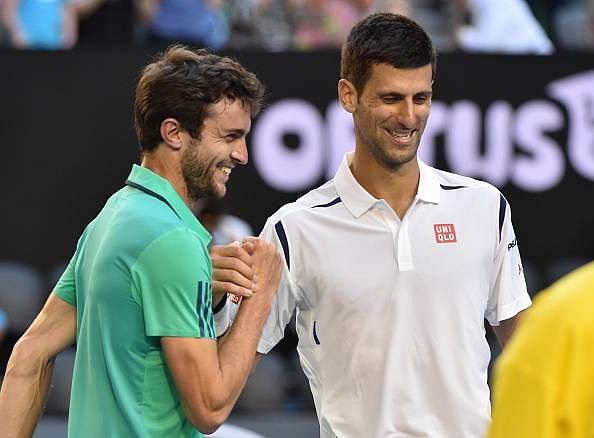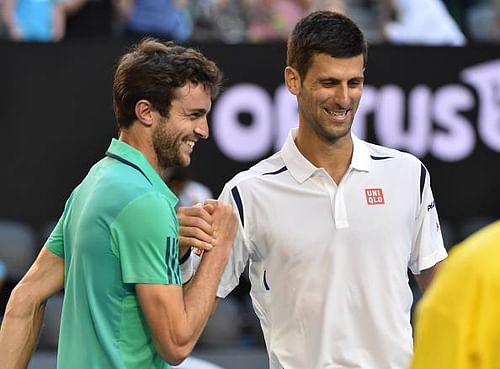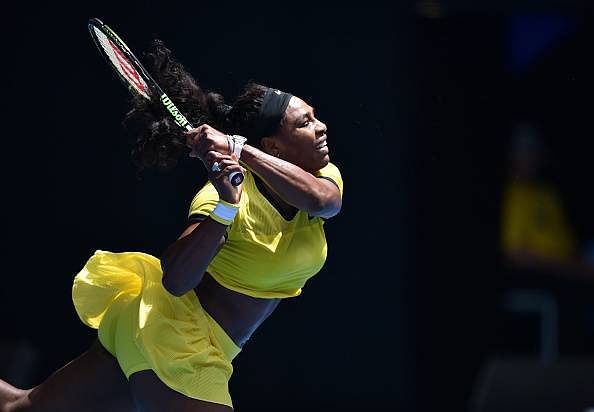
Australian Open diary: A classic that wasn't, and two GOATs showing the causes of their greatness
New sounds, new sights, new scenarios – if every day at a Grand Slam was considered an era by itself, tennis would be in a constant state of evolution. No two days of the Australian Open are even remotely similar, even though the same players (or most of the same players; the losers obviously go home) descend on the courts every alternate day.
The odd-numbered days at this year's edition have produced most of the mass appeal, with both the men's and the women's draws being top heavy. With Maria Sharapova, Novak Djokovic, Serena Williams, Roger Federer and Agnieszka Radwanska all in action on Day 7, there was never going to be any shortage of star value.
Here is a look at the most striking memories I will take back from today's play in Melbourne:
An five-setter ALWAYS seems better from the stands

Gilles Simon and Novak Djokovic sharing a laugh after their marathon 4th round match
I have written in the past that not every five-set marathon is worthy of being called a classic, and that holds especially true for today's fourth round match between Novak Djokovic and Gilles Simon. While the contest lasted 4.5 hours and involved several painstaking rallies, the quality of the play left a lot to be desired.
Djokovic was off his game for pretty much the entire match, and racked up a barely believable 100 unforced errors on the day. Yes, you read that right – the World No. 1, famous for his unerring defense and mind-numbing consistency off the ground, registered a century of shots that either limped into the net or sailed wildly past the lines.
So remarkable was the number that it was all anybody wanted to ask him about in the press conference. Did he remember any other match when he had struck 100 errors? "Not even close,” said Djokovic. “But there's a first time for everything!”
While the Serb could see the lighter side of it, he was under no illusions about his level. “I obviously didn't expect to make this many unforced errors,” he said. “In terms of the level that I played, it's a match to forget for me.”
Simon for his part battled valiantly, although even he botched his fair share of routine shots during the match. All of that translated into a contest which featured some spectacular defense going hand-in-hand with some downright poor offense. There were long rallies and fabulous gets right from the word go, but the two players also surrendered the initiative way too often, and failed to show enough urgency for vast stretches of play.
But try telling that to the thousands of spectators who were on their feet for much of the last three sets. They did groan in dismay or occasionally gasp in shock at every unexpected Djokovic error, but they were willing to forgive anything as long as Simon kept fighting at the other end.
And fight he did, right till the very end; he fought against Djokovic's superior stamina and fitness, and he also fought against his own lack of point-ending power. And while normally that may not be enough to challenge the World No. 1 or even to give the spectators their money's worth, today it achieved both of those things.
The noise in the stadium never went down after Simon won the second set, and the chants kept growing in intensity with each passing game. I'd even go as far as saying that the electric atmosphere in the arena added to the tension on the court. There was boisterous cheering for both Djokovic and Simon, and heartfelt applause at every point-ending shot – whether a winner or an unforced error.
That's what a long-drawn-out match can do, no matter what the quality of play. Djokovic vs Simon was no classic, but to the scores of people that filled the stands in Rod Laver Arena, it certainly was a memorable affair.
The terrifying and wonderful Serena Show

Serena Williams taking one of her full-blooded swings in the Australian Open 4th round
As I sat down for my first experience of watching Serena Williams live, I fully expected to be blown away by the majesty of her serve. After all, there have been very few shots in the history of tennis which have so unequivocally been considered the greatest of all time – the way the Serena serve is.
The shot certainly was impressive in her victory over Margarita Gasparyan today; she won 75% of her first serve points, and didn't face a break point after the first game of the match. But what struck me more sharply, and what I'll take back most vividly, was the ferocity of her groundstrokes. Serena doesn't hold back one bit when presented with a mid-court ball, to say the least.
The sound of Serena's racquet hitting the ball is unlike anything I've ever heard before – it's a sound that signifies force, fury and fire all at the same. And as it reverberates around the stadium, echoing menacingly off the bleachers, it even starts to sound scary to the spectators – making them question whether they should run for cover.
I can only imagine how intimidating it must be for her opponents to stand across the net and listen to that sound shot after shot.
That said, it's not just about the sound; even if her opponents played with earmuffs, they'd still be hard-pressed to get anywhere close to the ball once Serena has taken a whack at it. She hits each of her trigger-pulling shots with a Del Potro-like snap of the wrist, sending the ball scorching through the court with a flatness that seems to defy physics. There's very little margin for error in her game, but she somehow manages to make it work with incredible consistency.
The bottom line? You haven't seen pure power until you've seen Serena Williams unload on a groundstroke.
The mysteries of Roger Federer's backhand

Roger Federer hitting a backhand during his match against David Goffin
We've heard the drill for years now – Federer's backhand is a huge liability, Federer's backhand breaks down under pressure, Federer's backhand is weak and unreliable. But is the shot as much of a deficiency as it has been made out to be?
As I watched Federer cruise past David Goffin today, the first thing that leapt out at me is how early he takes the ball. This is all the more vivid because of how different his contact point looks compared to every other player. No one, and I mean no one, hits the ball on the rise as frequently as Federer does, and that simple fact can put a lot of things into perspective.
A one-handed backhand is typically easier to hit early, and the Swiss has probably got that idea permanently ingrained in his mind. He hits every single backhand on the up, which causes the ball to loop higher than most other players’ backhands. That way he can take time away from his opponents, and can surprise them with sudden changes in direction. But it also means he can hardly ever take a big cut on the shot, which in turn means less weight on the ball.
Because of this early contact point, if Federer is even slightly off with his timing (as he has been quite often ever since he passed his prime), it results in a seemingly inexplicable error. Moreover, if he doesn't guide the backhand exactly where he wants it to land (which is usually a corner), the opponent has an easier shot to deal with, because of the lesser pace and greater loop.
So the obvious question here is – why does he do it? Why is he so stubborn about taking the ball early, and sacrificing his consistency and power in the process? Would it not be easier to move a little back and hit the shot at a more conservative contact point, the way everybody else does?
The answer can be perfectly summed up in one word: positioning. Federer is obsessive about staying close to the baseline at all times, and not without reason. The same things that make his backhand relatively weak, work like magic for his forehand.
Because he takes the ball so early, and because he's got such tremendous racquet head speed on the forehand, he can do anything that he wants with that shot. He can hit it up the line or crosscourt from the same place, strike it flat or with topspin, stab a reflex return when needed and unfurl a precise half volley when left stranded.
Federer would not have been the legend that he is today without his supremely versatile forehand, and he wouldn't have had that forehand if he didn't stay rooted to the baseline at all times. But this has a very visible side effect: it makes his backhand look like a secondary and often unreliable weapon, even though he can do a lot of damage with it when he's timing the ball well (just re-watch the Wimbledon semifinal from last year, and you'll see what I'm talking about).
There are many reasons why Federer is widely considered to be the greatest player of all time. His insistence on taking the ball early, which has the effect of making his backhand look bad, may be the single most important of those reasons.